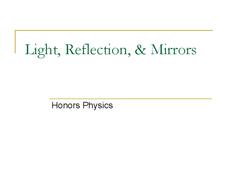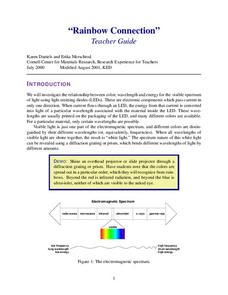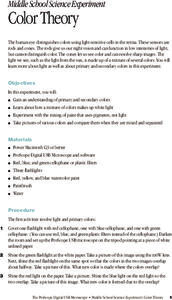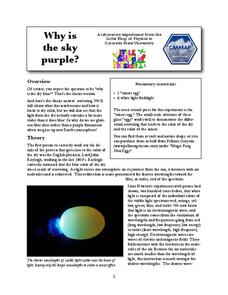Colorado State University
Why Are Clouds White?
Is it possible to change the color of clouds? A three-part activity explores the scattering of light by the water droplets that make up clouds. After observing a demonstration, curious scholars conduct their own investigations of the...
Glynn County School System
Light, History, Gravity, Distance, Relativity, and Space-Time
Let the star's color be the guide! The color of a star indicates its temperature and its mass and distance affect the gravitational force. The lesson presentations address these concepts as well as how the theory of special relativity...
Carnegie Mellon University
Consumer Preferences in Lighting
What is a watt? This tongue-twisting, mind-bending question and others are answered through this lesson on the different lighting options available. With the support of a PowerPoint, teach your physical science class about units of...
NASA
Taking Apart the Light
Break down light into spectra. Scholars learn how atoms emit and absorb photons and come to understand how this process allows scientists to identify different atoms based on either absorption lines or emission lines. Learners then...
Bowels Physics
Light, Reflection, and Mirrors
Explore the connection of light, reflection, and mirrors. A comprehensive lesson introduces the basics of light in relation to reflection and mirrors. After an explanation of the vocabulary, the presentation shows how to create ray...
PBS
Light Absorption: Effects of Light | UNC-TV Science
Beat the summer heat by exploring the properties of color. Scientists view a video explaining the relationship between light absorption and energy transfer using variables including intensity, time, and wavelength. A multiple-choice...
Exploratorium
Blue Sky
Use a container full of water as a prism and show that as light is bent, the individual colors from different wavelengths become visible. This explains why the sky appears to be blue midday, and why as the sun nears the horizon, it looks...
Physics Classroom
Light Intensity
Light intensity varies by the strength of the light bulb as well as the distance to the light bulb. Pupils apply these concepts independently at first. They must solve for the light intensity as either the distance or the wattage of the...
Curated OER
Color Combinations
Students develop a basic understanding of how color is perceived by the eye. They utilize the technique Seurat used to paint A Sunday on La Grande Jatte to create their own paintings.
Curated OER
Discovering the Element of Color in Gaetano Donizetti's Don Pasquale: A Comparison of Tone Color and Art Color
Students experience several different tone colors in the song and also add layers of color to their copy of "The Owl" to compare and contrast how an artist would create the element of color.
Curated OER
ELEMENTS OF DESIGN IN TWENTIETH CENTURY ART
Students examine the elements of design: line, shape, color, space, texture, light. They refer to these elements of design when they view works of art and create their own artwork. They visit the National Gallery Museum.
Curated OER
Diffraction of Laser Light, Polarization and Color Filters
Students investigate light behavior by conducting a series of experiments. In this physics instructional activity, students calculate the wavelength of the light source using an equation. They determine what color is produced when light...
Cornell University
LEDs Rainbow Connection
View LED lights through the eyes of a scientist. Young scholars learn to view light as a wave frequency and connect various frequencies to different colors on the light spectrum. A lab activity asks groups to measure the frequency of...
Cornell University
Light Waves: Grades 6-8
Explore the behavior of light with different materials. Collaborative groups determine whether certain materials absorb, reflect, diffract, or transmit light waves. They then measure the angle of incidence and angle of reflection.
Curated OER
How Many Rocks Does it Take to Make a Light Bulb?
A really good worksheet on the periodic table of the elements is here for you. Learners must color in the elements listed in the worksheet that are needed to make a light bulb. They then answer questions about each of the elements.
Curated OER
Color Change in Leaves
High schoolers identify the different leaf pigments and colors. In this biology activity, students perform chromatography to separate them. They explain how light affects green leaf colors and causes falling leaves in autumn.
Curated OER
Color Theory
Students are able to gain an understanding of primary and secondary colors. They are able to explore about how a mixture of colors makes up white light. Students are able to experiment with the mixing of paint that uses pigments, not...
Colorado State University
Why Is the Sky Purple?
The color of the sky depends on the time of day. Young scholars experiment with scattering different wavelengths of light to recreate the color of the sky. They observe both the longer blue wavelengths and the shorter red and orange...
Howard Hughes Medical Institute
Understanding Variation
Does where we live influence how our bodies express genetic traits? Explore variation in human skin color with an activity that incorporate video and hands-on learning. Individuals model the relationship between phenotypes and genotypes,...
International Technology Education Association
Singin' the Black and Blues
How does the color of the sky change from blue to reds and oranges to black? An illuminating lesson explains how light travels through different mediums using the sun's light as an example. By examining diagrams and illustrations, pupils...
Curated OER
Fall 2003 Midterm Exam #3
Let there be light! When your physics learners take this midterm exam, light will be their focus. They will show what they know about electromagnetic waves, interference, refraction, reflection, lenses, prisms, and more! The test is...
American Museum of Natural History
Draw a Monarch
Five steps walk scholars through the process of drawing a Monarch butterfly. Participants research the insect, make observations, trace, then color.
Curated OER
All Those Seeing Color, Say Eye!
Students research and discuss the roles of the eye and brain in the perception of color. They watch a slideshow and complete a worksheet.
Curated OER
In Living Color
Students explore, through discussion and experimentation, colorblindness and how the color of the light passing through the eye changes how different colors are perceived.
Other popular searches
- Light and Color
- Properties of Light and Color
- Color and Light Absorption
- Light and Color Spectrum
- Visible Light and Color
- Light Energy & Color
- Light Reflection and Color
- Primary Color of Light
- Light and Color Prism
- Light Color
- Visible Light Color
- White Light and Color























